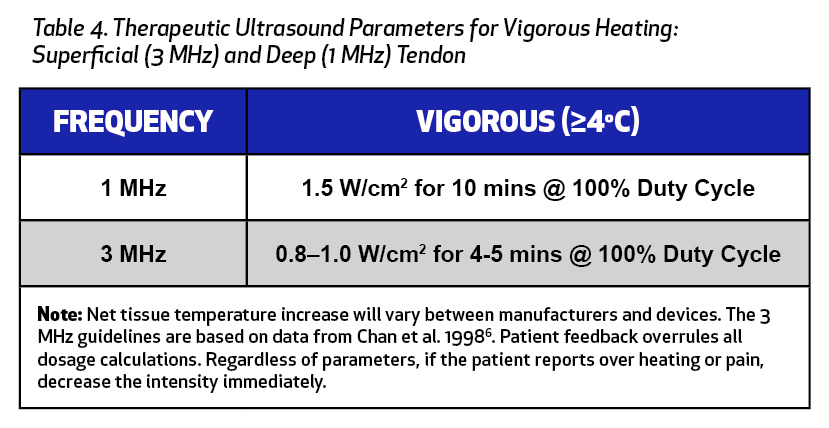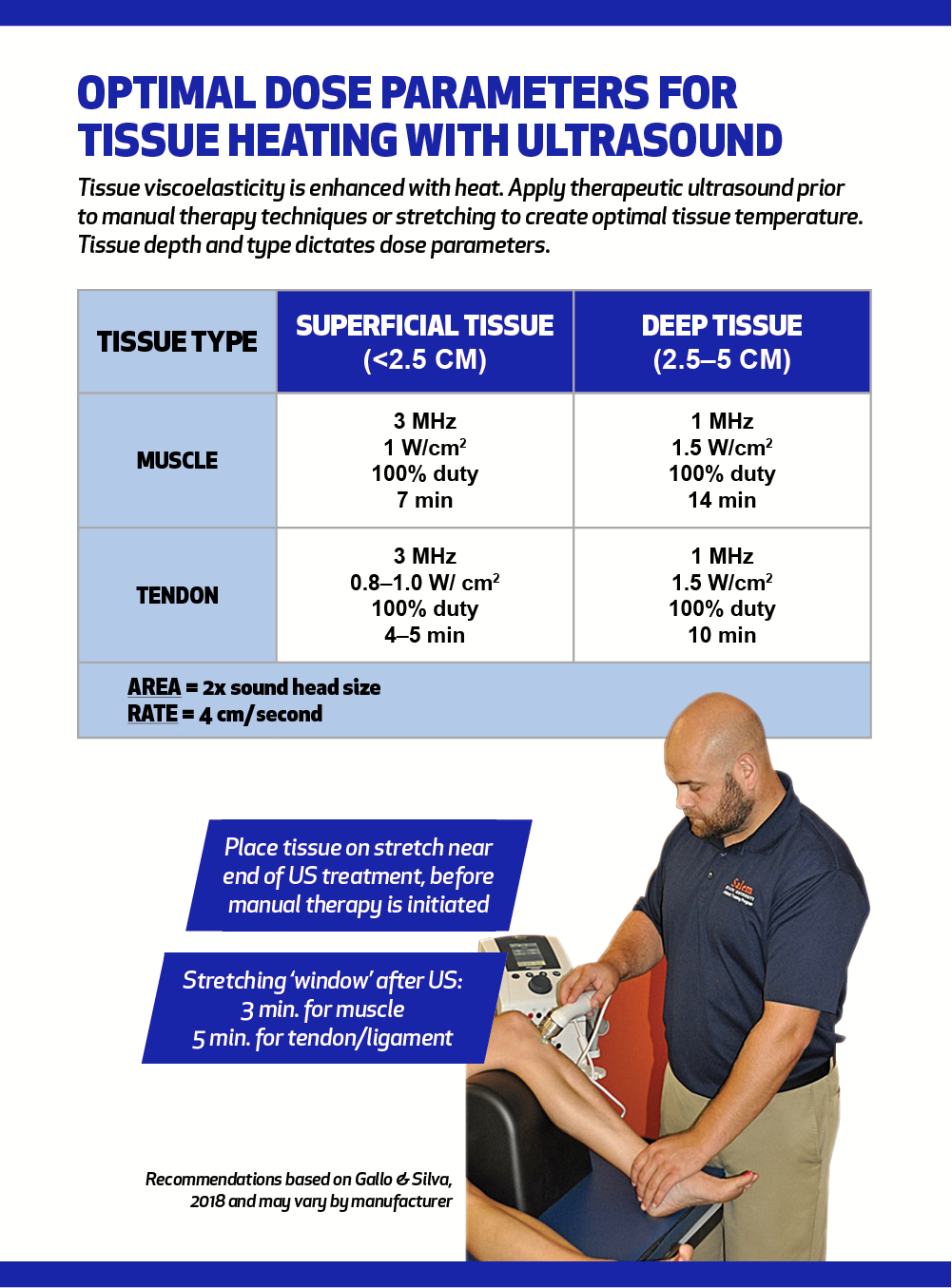One of the most commonly used physical modalities in the rehabilitation practice is therapeutic ultrasound.
“In particular, therapeutic ultrasound in rehabilitation has a number of uses including the treatment of musculoskeletal disorders such as pain, muscle spasm, joint contracture, and tissue injury. Therefore, it is now recognized as a major therapeutic method in treating musculoskeletal disorders.” [1]
Ultrasound can be used for deep heating tendons, muscles and ligaments. This can help the healing process by increasing circulation to the tissues. Using deep heat from ultrasound can help the flexibility of the tissues before beginning exercises which can improve the stretching that is being done.
Using a deep heating agent before beginning a “heat and stretch” intervention may be the best thing for you and your patients. Although there is the decision to use a superficial heating agent as well, there is evidence that shows it might not be the most beneficial option between the two.
Regardless, we can all agree that outcomes are better when using a combined approach compared to just the use of modalities alone. That has been made clear in findings about electrophysical agents. Let’s take a look at how to heat tissues to therapeutic temperature ranges while preparing for stretching and manual therapy.
Hot packs, an example of a superficial heating agent, are a popular choice among clinicians when using the “heat and stretch” method. The problem with superficial heating agents is that they only have the maximum ability to penetrate up to 1-2 cm. Even when the superficial heating agent reaches a depth greater than 1 cm, they are unable to rise tissue temperatures to the necessary therapeutic range. [2]
Because of that, a clinician may want to find something that would be more likely to penetrate to a deeper level in the tissues. Deep heating agents, such as therapeutic ultrasound and shortwave diathermy are able to effectively heat the tissues up to 5 cm. [3]
Vigorous heating is when the baseline tissue temperature is raised by 4°C or reaches an absolute tissue temperature of 40°C. Therapeutic ultrasound can adequately heat the tissue to a therapeutic level which increases tissue viscoelasticity.
According to members of the Sport and Movement Science Department at Salem State University, Joseph A. Gallow and Kevin J. Silva, “It is important to note that baseline intramuscular tissue temperature is approximately 36°C. This 4°C increase is believed to maximize viscoelasticity of soft tissue during and immediately after treatment, and is the basis for the wide spread use of pre-heating tissue immediately before stretching and manual therapy techniques. [1,4] Additional research is needed to determine the comparative effectiveness of combining deep heat with manual techniques.” [5]
Increasing the tissue temperature by just those 4°C could be the perfect number. It used to be thought that temperatures between 40-45°C were needed to increase the viscoelasticity in tissues. This was because of early research that was completed using animal subjects. [6]
Updated research on ultrasound has shown that tissue temperatures above 41°C are not tolerated well by human subjects. [7]

Looking at the table below, you can see the therapeutic ultrasound heating rates per minute in human muscle. In the study done by Draper et al., a dose response relationship was established for heating muscle with both 1 and 3 MHz ultrasound. [3] This allowed clinicians to be able to select both treatment times and intensities that can have outcomes predicting heating in human muscle.
Because of the different manufacturers and devices, heating rates can vary which will cause tissue temperature increase to vary.

Which frequency works best for superficial compared to deep muscle? The penetration depth and efficiency of heating are both affected by the frequency used. 3 MHz should be used when the tissues targeted are within 2.5 cm. [8] 3 MHz is a much more efficient frequency in regards to heating because it heats roughly 3x faster than 1 MHz. [3] 1 MHz should be used when wanting to affect deeper tissues. That would be considered up to 5 cm deep. Because it has the capacity to be a deep heating agent, it is also an inefficient heater of deeper muscle which requires greater sonation time.
“Conversely, ultrasound is a reasonably efficient heater of superficial muscle and is the most efficient heater of superficial tendons because of the increased collagen content.” [5]
When using ultrasound, the area being treated should be no more than 2x the size of the sound head. This is because ultrasound is a focused treatment and heating efficiency will be affected by the technique used. By moving the sound head in an overlapping circular or longitudinal pattern at a rate of 4 cm per second, the heating effect will be maximized.


It is important to know that there is a limited time frame after using ultrasound for stretching. By combining vigorous heating and stretching or manual therapy, local blood flow and tissue extensibility are increased. The time you have after using ultrasound is 3.3 minutes for muscle stretching and 5 minutes for tendon and ligament stretching. [9,10] The reason for this is that the temperature and viscoelasticity are greatest during these time periods.
“Near the end of an ultrasound treatment, place the target tissue on stretch to maximize tissue elongation, and immediately follow the treatment with stretching, joint mobilizations, or instrument assisted soft tissue mobilization. The literature is clear that ultrasound can elevate tissue temperature to a vigorous level prior to stretching and manual therapies when dosed and applied correctly.” [5]
Download the infographic below for optimal dose parameters for tissue heating with ultrasound!

Sources:
[1] Morishita, Katsuyuki et al. “Effects of Therapeutic Ultrasound on Range of Motion and Stretch Pain.” Journal of Physical Therapy Science 26.5 (2014): 711–715. PMC. Web. 24 Sept. 2018.
[2] Draper, D. Therapeutic ultrasound. In: Knight KL, Draper DO. Therapeutic Modalities: The Art and Science. 2nd ed. Philadelphia, PA: Lippincott Williams & Wilkins; 2013.
[3] Draper DO, Castel JC, Castel D. Rate of temperature increase in human muscle during 1 MHz and 3 MHz continuous ultrasound. J Orthop Sports Phys Ther. 1995;22(4):304-307.
[4] Draper DO. Ultrasound and Joint Mobilization for achieving normal wrist range of motion after injury or surgery: A case series. J Ath Train. 2010;45(5):486-491.
[5] https://cramerstaging.performancehealthdev.com/first-aider/dosing-therapeutic-ultrasound-to-induce-vigorous-heating-prior-to-stretching-and-manual-therapy.html
[6] Lehman JF, De Lateur BJ. Therapeutic Heat. In: Lehman J, and Therapeutic Heat and Cold. 4th ed. Baltimore, MD: Williams & Wilkins; 1990.
[7] Merrick MA, Bernard KD, Devor ST, Williams JM. Identical 3-MHz ultrasound treatments with different devices produce different intramuscular temperatures. J Ortho Sports Phys Ther. 2003;33(7):379-385.
[8] Hayes BT, Merrick MA, Sandrey MA, Cordova ML. Three-MHz ultrasound heats deeper into the tissue than originally theorized. J Ath Train. 2004; 39(3):230-234.
[9] Rose S, Draper DO, Schulthies SS, Durrant E. The stretching window part two: rate of thermal decay in deep muscle following 1 MHz ultrasound. J Ath Train. 1996; 31(2): 139-143.
[10] Draper DO, Ricard MD. Rate of thermal decay in human muscle following 3 MH ultrasound: The stretching window revealed. J Ath Train. 1995; 30(4):304-307.